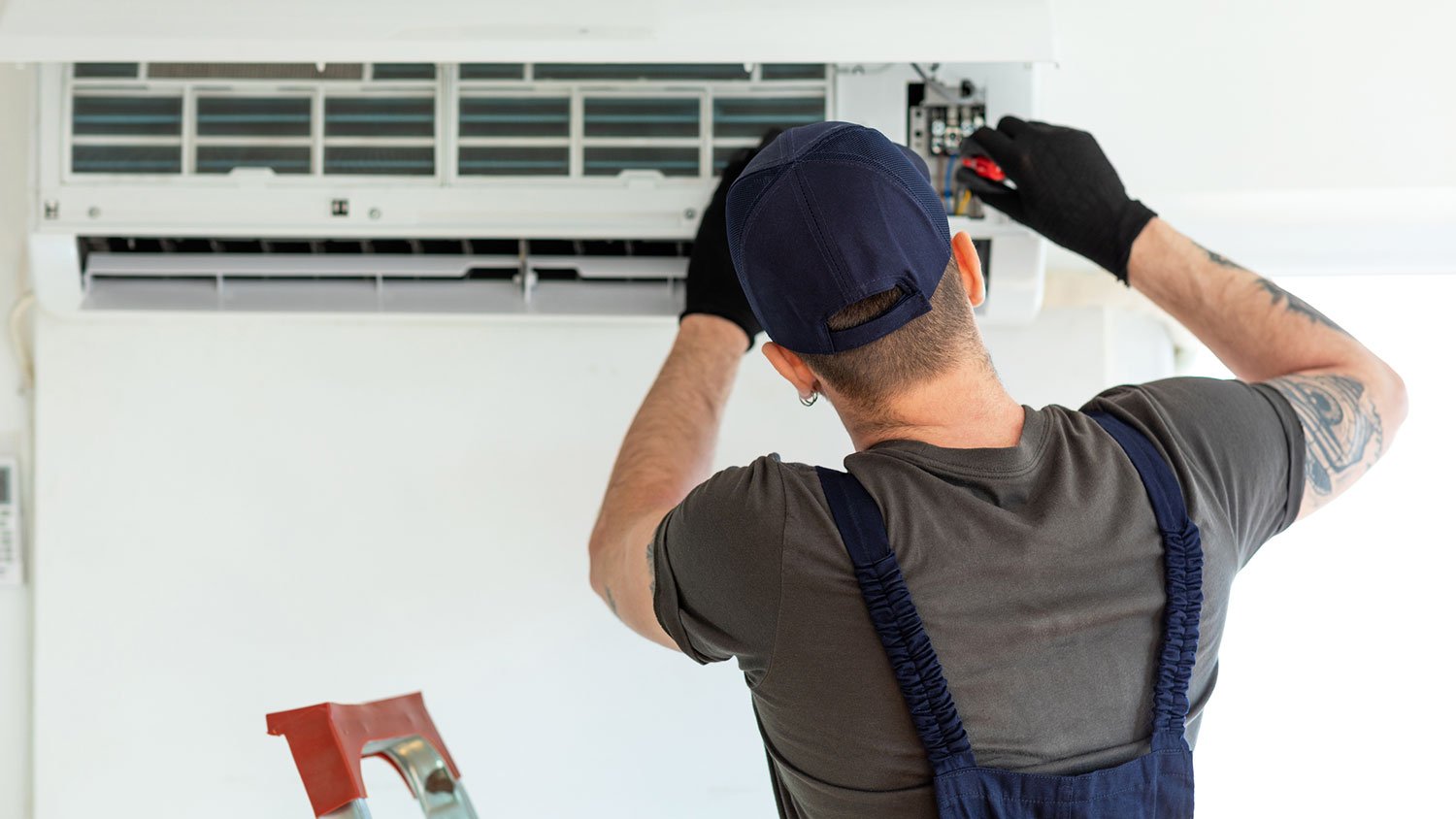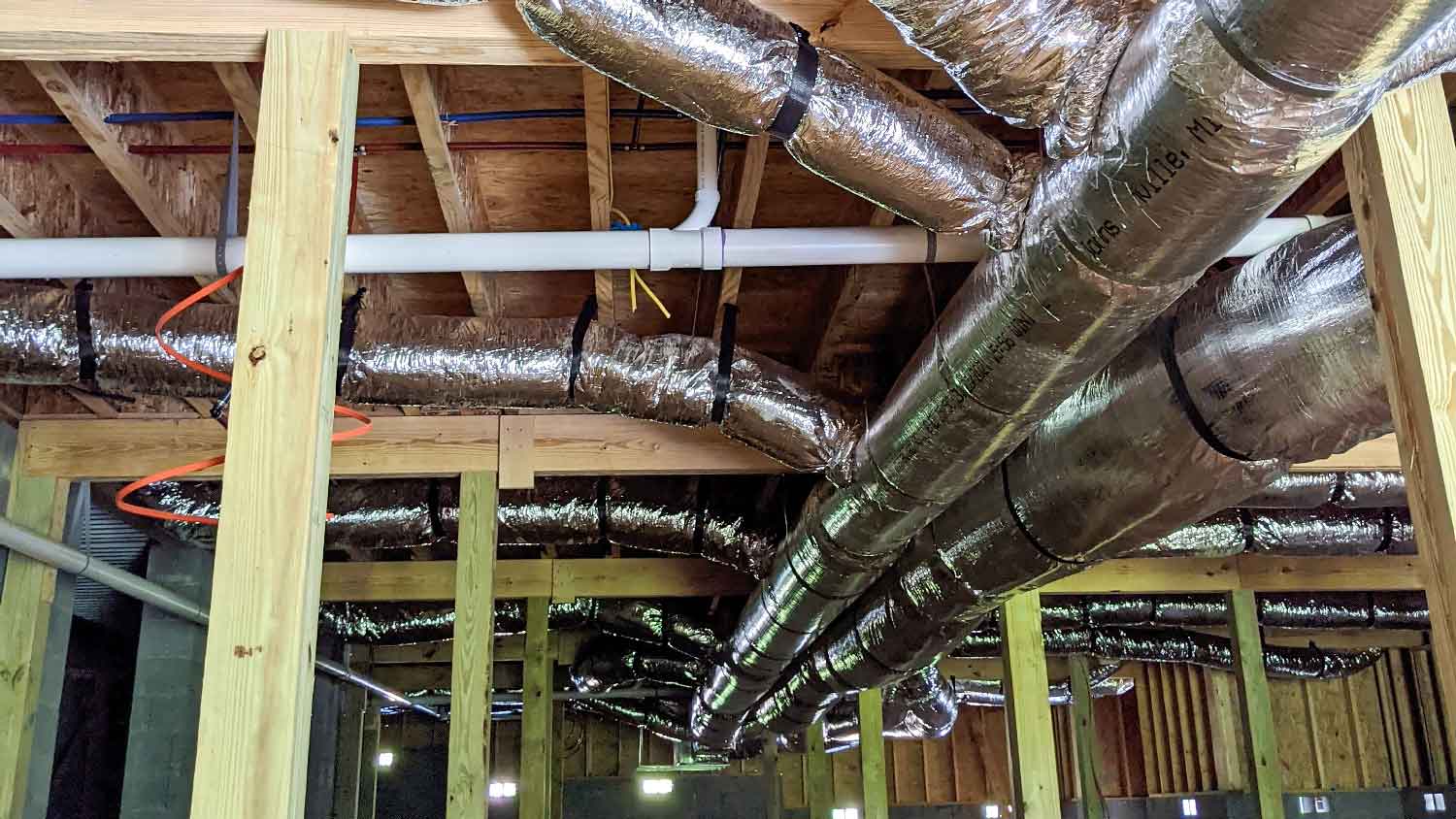
Discover the true window AC unit installation cost to learn about labor, permits, and ways to save on your window AC project.
Clear the way for cool goodness


A clogged AC drain line can cause leaks and mold growth if not properly addressed.
Professional AC drain unclogging costs anywhere from $147 to $345, and a pro can safely handle this project in a shorter timeline.
Unclogging an air conditioning drain line takes specialized expertise that only a seasoned pro will have.
A local HVAC expert will be able to determine how bad the clog is and what tools are needed to get your line in the clear again.
When your air conditioning system is running smoothly, it's easy to overlook the importance of its drain line. However, a clogged AC drain line can quickly become a major headache, leading to water damage, reduced cooling efficiency, and even mold growth. Let’s explore why this common HVAC problem occurs, how to recognize the signs of a clog, and the best methods for unclogging and preventing future blockages.
Your air conditioning system produces condensation as it cools warm air. This moisture needs to be removed from the system to prevent humidity buildup and potential damage. That's where the AC drain line comes in. It's responsible for channeling excess water away from the unit and safely draining it outside your home.
Despite its vital role, the AC drain line is susceptible to clogs. Several factors in your cooling system can contribute to blockages. The most common reason for a clog is the presence of foreign objects. Dust, dirt, and other debris can enter the drain line, especially if the system's air filter is dirty or clogged. This debris can accumulate and obstruct the flow of water.
Algae and mold growth can also cause a clogged AC drain line. The dark, damp environment inside the drain line is the perfect breeding ground for these organisms, and over time, they can accumulate and form blockages. Additionally, if the AC drain line is not installed correctly or lacks proper slope, water may not flow efficiently, increasing the risk of clogs.
Identifying a clogged drain line early can prevent potential damage and stop you from needing to pay for expensive HVAC repairs. Look out for these warning signs:
Pooling water: If you notice water leaking around your AC unit or water stains on the walls or ceiling nearby, it could indicate a clog in the drain line.
Musty odors: A clogged drain line creates a stagnant environment perfect for mold and mildew growth, leading to unpleasant odors emanating from the AC vents.
Reduced cooling performance: A blockage can affect the efficiency of your AC system, resulting in decreased cooling capacity and higher energy bills.
Visible mold or algae: If you inspect the drain line and notice visible mold or algae growth, it's a clear sign of a clog that needs attention.
If you're confident in tackling the clog yourself, you’ll have to start at the access point to your AC drain line. You can find it near the indoor air handler unit or the exterior condenser unit. Note that it’s important to shut off power prior to doing any work on your HVAC system to ensure safety, and you can restore power once your work is complete.
To clear a clog caused by organic matter, you can flush the drain line with clean water, a mixture of vinegar and water, or even bleach. The flushing method is particularly effective at dissolving buildup from mold and algae. Vinegar is safer for the environment and less corrosive, while bleach is more potent but requires careful handling to avoid damage to surrounding surfaces and components.
Using a wet/dry vacuum is an effective method to unclog an AC drain line. By creating suction, the vacuum can dislodge and remove debris, restoring proper drainage. It's a simple and efficient DIY solution, especially for stubborn clogs that may not respond to other methods. If the clog persists, you may need to hire an HVAC professional to help.
Blowing air into the drain line with an air compressor is another effective approach to get rid of tougher clogs. A burst of pressurized air can dislodge debris that’s obstructing the line, restoring proper drainage. Use caution if you decide to try this method because you could damage the line if you’re not careful.
Using a plumbing snake is a viable method to remove the toughest clogs that the previous methods couldn’t clear. By inserting the snake into the line and maneuvering it carefully, you can dislodge and remove stubborn blockages, restoring proper drainage and airflow in your HVAC system.
While DIY solutions can sometimes resolve minor clogs, more severe blockages may require the expertise of a local AC repair company. For example, simple DIY methods like flushing the drain line with vinegar or using a wet/dry vacuum can often clear minor clogs. However, if you're not comfortable working with HVAC systems or the clog persists, it's best to seek professional assistance.
HVAC technicians have the tools, knowledge, and experience to diagnose and address clogged AC drain lines safely and effectively. They can also inspect the entire system for any issues that may contribute to clogs.

Ignoring a clogged AC drain line can have serious consequences like water damage, mold and mildew growth, and reduced HVAC efficiency. Excess water from a clogged drain line can leak into your home and cause water damage to walls, ceilings, and flooring.
Standing water and high humidity resulting from a clog also provide the perfect environment for mold and mildew growth, meaning your health is at risk. Plus, you’ll have to pay for costly mold remediation. And, of course, your energy bill may rise due to a clogged drain line since it can impair the efficiency of your system.
If your AC drain line keeps clogging, follow these preventive measures to stop future blockages:
Regular maintenance: Schedule annual maintenance for your HVAC system, which includes cleaning and inspecting the drain line.
Change filters: Replace AC filters regularly to prevent dust and debris from entering the system and creating clogs.
Keep the surrounding area clean: Keep the area around your AC unit clean and free of debris to minimize the risk of clogs.
Install a drain line cleaner: Consider installing a drain line cleaner or algaecide treatment to prevent algae and mold growth.
He was very personable and punctual.
I had Elite out to quote installing an inline duct booster since our upstairs had low airflow and I was pretty sure I'd tried everything on the dampers downstairs to balance it out. Turns out I'm not as clever as I thought—Trevor went through and figured out that the line I thought was the...
They did an excellent job! Every single worker was very friendly and professional, very careful with our plants in the yard. Did a great and safe job removing dead and dangerous branches and even cleaned up after themselves. Price was very reasonable as well; we'd hire them again in a heartbeat!
they replaced individual shingles that were damaged by hail. house approx 8 yrsold, roof in good condition. they did not try to sell whole new roof. good people.
My back yard slopes considerably down and away from the back of the house and an unsightly/unstable retention mound of rubble and soil left the area close to the back of the house and under the 2nd story high deck pretty much unusable. Jeremy removed the rubble, reshaped the nondescript...
From average costs to expert advice, get all the answers you need to get your job done.

Discover the true window AC unit installation cost to learn about labor, permits, and ways to save on your window AC project.

Discover the cost to install ductwork. Learn about average prices, cost factors, and tips to save money on your ductwork installation project.

Find out the average humidifier repair cost, what impacts pricing, and how to save. Get expert tips to budget for your humidifier repair.

Are you considering adding a whole-house humidifier to your home? Keep reading to learn the pros and cons of a whole-house humidifier.

Learn how to add Freon to your AC unit with our step-by-step guide, and keep your home cool with a properly functioning AC unit.
Furnace trouble can be frustrating, so learning the telltale signs of a failing furnace is important. Recognize the following red flags for a malfunctioning furnace.